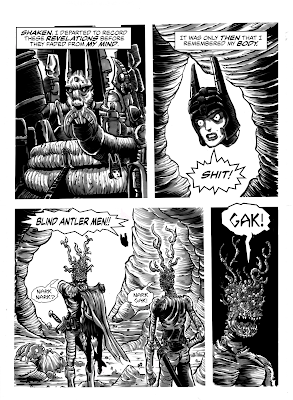(Dutch: De Doder van Eriban) (part 2)
Art by Don Lawrence; script by Martin Lodewijk
Once the young assassin was meditated and determined their destination, he fills our heroes in on his backstory. On Eriban, boys and girls are taken at a young age to train in the Academy of Assassins. They never know their own parents. They are trained to identify poisonous planets from all over Pandarve and learn to fight with a variety of animal life. They must master every form of weapon and none may graduate until they have killed a dream projection of one of their teachers.
Upon completion of their training, they are given a graduation assassination to perfom. Renter's assignment is to kill the monarch of a small kingdom not far from their location.
His original servants met with an untimely fate. The ship ran into a m'anganesse swarm. The legendary insects swarm in the millions and destroy every living thing in their path.
While his servants sacrificed himself for him, Ranter was safe in a timeless stasis in the regeneration capsule.
On the course Renter dictates, the windstream carries them farther and farther from Pandarve. After a week, they reach their destination:
TO BE CONTINUED


























